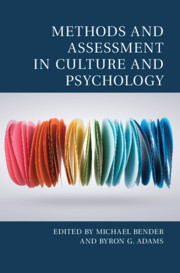Book contents
- Methods and Assessment in Culture and Psychology
- Culture and Psychology
- Methods and Assessment in Culture and Psychology
- Copyright page
- Dedication
- Additional material
- Contents
- Figures
- Tables
- Contributors
- Foreword
- 1 Introduction to Methods and Assessment in Culture and Psychology
- Part 1 Acculturation and Identity
- Part 2 Individual Differences across Cultures
- 6 Broadening the Bases of Methodological Rigor in Cross-Cultural Educational Assessment
- 7 Individuals, Groups, and Classrooms: Conceptual and Methodological Considerations on Studying Approaches to Cultural Diversity in Schools
- 8 Emotion between Universalism and Relativism: Finding a Standard for Comparison in Cross-Cultural Emotion Research
- 9 Culture Is More Than Self-Reported Motives, Beliefs, and Values: Methodological Advancements of Measuring Implicit Motives across Cultural Contexts
- 10 Development of the South African Personality Inventory: A Cross-Cultural Design in a Non-Western Society ‒ Lessons Learned and Generalizability to Other Parts of the World
- 11 Combining Global and Local Approaches in Psycholexical Studies: Glocal Illustrations from Studies on Arabic
- Part 3 Culture and Assessment
- Index
- References
7 - Individuals, Groups, and Classrooms: Conceptual and Methodological Considerations on Studying Approaches to Cultural Diversity in Schools
from Part 2 - Individual Differences across Cultures
Published online by Cambridge University Press: 21 January 2021
- Methods and Assessment in Culture and Psychology
- Culture and Psychology
- Methods and Assessment in Culture and Psychology
- Copyright page
- Dedication
- Additional material
- Contents
- Figures
- Tables
- Contributors
- Foreword
- 1 Introduction to Methods and Assessment in Culture and Psychology
- Part 1 Acculturation and Identity
- Part 2 Individual Differences across Cultures
- 6 Broadening the Bases of Methodological Rigor in Cross-Cultural Educational Assessment
- 7 Individuals, Groups, and Classrooms: Conceptual and Methodological Considerations on Studying Approaches to Cultural Diversity in Schools
- 8 Emotion between Universalism and Relativism: Finding a Standard for Comparison in Cross-Cultural Emotion Research
- 9 Culture Is More Than Self-Reported Motives, Beliefs, and Values: Methodological Advancements of Measuring Implicit Motives across Cultural Contexts
- 10 Development of the South African Personality Inventory: A Cross-Cultural Design in a Non-Western Society ‒ Lessons Learned and Generalizability to Other Parts of the World
- 11 Combining Global and Local Approaches in Psycholexical Studies: Glocal Illustrations from Studies on Arabic
- Part 3 Culture and Assessment
- Index
- References
Summary
Understanding how schools should approach increasing cultural diversity is a key research question of the 21st century. In this chapter, we provide recommendations to ensure that measures of approaches to cultural diversity in schools are theoretically sound, valid, and reliable in different groups and at different levels of analysis. We argue that (1) we need measures that are tailored to and / or reliably work in specific target populations, in terms of ethnic groups represented and age-specific notions of culture and intercultural relations; (2) both students’ individually perceived norms AND shared perceptions of these norms should be considered to better understand the dynamics in multi-ethnic classrooms. Interactions within and between levels different levels of analysis can shed light on group-specific effects of approaches to cultural diversity in schools; and (3) “objective” measures of the school diversity context (e.g., school projects or policies) may help to better understand contextual effects.
- Type
- Chapter
- Information
- Methods and Assessment in Culture and Psychology , pp. 123 - 143Publisher: Cambridge University PressPrint publication year: 2021
References
- 2
- Cited by



